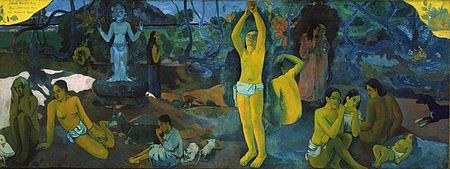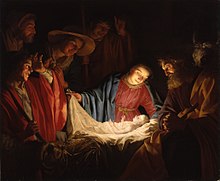Nativity Fast
|
Read other articles:

Sceaux 行政国 フランス地域圏 (Région) イル=ド=フランス地域圏県 (département) オー=ド=セーヌ県郡 (arrondissement) アントニー郡小郡 (canton) 小郡庁所在地INSEEコード 92071郵便番号 92330市長(任期) フィリップ・ローラン(2008年-2014年)自治体間連合 (fr) メトロポール・デュ・グラン・パリ人口動態人口 19,679人(2007年)人口密度 5466人/km2住民の呼称 Scéens地理座標 北緯48度46�…

Le Burkina Faso est divisé en 45 provinces regroupées dans 13 régions. Histoire Les provinces ont été, jusqu'en 2001, la principale subdivision territoriale du pays avec à leur tête un conseil provincial. En 1995, la liste des provinces s'est beaucoup allongée, passant de 30 à 45 lorsque 15 des départements les plus peuplés ont été érigés en provinces séparées de leur province d'origine (ces nouvelles provinces, alors codées par l'INSD de 31 à 45, ont été elles-mêmes divis�…

2016年美國總統選舉 ← 2012 2016年11月8日 2020 → 538個選舉人團席位獲勝需270票民意調查投票率55.7%[1][2] ▲ 0.8 % 获提名人 唐納·川普 希拉莉·克林頓 政党 共和黨 民主党 家鄉州 紐約州 紐約州 竞选搭档 迈克·彭斯 蒂姆·凱恩 选举人票 304[3][4][註 1] 227[5] 胜出州/省 30 + 緬-2 20 + DC 民選得票 62,984,828[6] 65,853,514[6] 得…

Ahmadinejad in 2005. Some former hostages have identified the man in the military jacket on the hostage's left as Ahmadinejad. Other sources, including Ahmadinejad and other hostage takers have disputed this identification. On June 29, 2005, shortly after Mahmoud Ahmadinejad won the Iranian presidential election, several major news outlets publicized allegations that he had gunned down several Americans during the 1979–1981 Iran Hostage Crisis. Ahmadinejad and his political supporters have den…

Частина серії проФілософіяLeft to right: Plato, Kant, Nietzsche, Buddha, Confucius, AverroesПлатонКантНіцшеБуддаКонфуційАверроес Філософи Епістемологи Естетики Етики Логіки Метафізики Соціально-політичні філософи Традиції Аналітична Арістотелівська Африканська Близькосхідна іранська Буддійсь…

本表是動態列表,或許永遠不會完結。歡迎您參考可靠來源來查漏補缺。 潛伏於中華民國國軍中的中共間諜列表收錄根據公開資料來源,曾潛伏於中華民國國軍、被中國共產黨聲稱或承認,或者遭中華民國政府調查審判,為中華人民共和國和中國人民解放軍進行間諜行為的人物。以下列表以現今可查知時間為準,正確的間諜活動或洩漏機密時間可能早於或晚於以下所歸類�…

Alfabeto nabateo Tipo alfabeto consonánticoIdiomas Arameo nabateoÉpoca siglo II a. C. - siglo IV d. C.Antecesores Jeroglíficos egipciosAlfabeto fenicioAlfabeto arameoAlfabeto nabateo Dio lugar a alfabeto árabeDirección sinistroversoUnicode U+10880-108AFISO 15924 Nbat, 159[editar datos en Wikidata] El alfabeto nabateo es el sistema de escritura consonántico que fue utilizado por los nabateos, a partir del siglo II a. C., para la escritu…

Popular spirit made in Ireland For the novel, see Irish Whiskey (novel). Irish whiskeyThree Irish whiskeys: Knappogue Castle, Jameson, and BushmillsTypeDistilled beverageCountry of origin IrelandIntroduced13th–15th centuryAlcohol by volume 40–94.8%Proof (US)80–189.6°ColourPale gold to dark amberFlavoursmooth, sharp, hint of vanillaIngredientsMalt, waterVariantsPot Still Irish WhiskeyMalt Irish WhiskeyGrain Irish WhiskeyBlended Irish WhiskeyRelated products Scotch whisky English …

Regarding the activities required to achieve a desired goal Forethought redirects here. For the defunct software company, see Forethought, Inc. This article is about the concept. For urban planning, often referred to as simply planning, see urban planning. For other uses, see plan (disambiguation). Part of a series onPlanning Planning Planning Goal Psychology Intention (Implementation intention) Business Business plan Automated planning and scheduling Motion planning Multi-agent planning Partial…

Chinese revolutionary figure and politician Gu Mu谷牧Gu Mu in 1940Vice Premier of the People's Republic of ChinaIn office1975–1982PremierZhou EnlaiHua GuofengZhao Ziyang Personal detailsBornSeptember 1914Rongcheng, ShandongDiedNovember 6, 2009 (aged 95)BeijingPolitical partyCommunist Party of ChinaChildren4 sons, 1 daughter In this Chinese name, the family name is Gu. Gu Mu (Chinese: 谷牧; pinyin: Gǔ Mù; Wade–Giles: Ku3 Mu4; September 1914 – November 6, 2009) was a Chines…

「離島」、「飛地」、あるいは「自治州」とは異なります。 海外領土・自治領の一覧(かいがいりょうど・じちりょうのいちらん)は、世界に存在する「独立国家以外の地域」の一覧である。 海外領土・自治領を示した世界地図 豪 智 丁 仏 &…

County in New Jersey, United States County in New JerseySomerset CountyCountySomerset County courthouse in Somerville, the county seat FlagSealLocation within the U.S. state of New JerseyNew Jersey's location within the U.S.Coordinates: 40°34′N 74°37′W / 40.56°N 74.61°W / 40.56; -74.61Country United StatesState New JerseyFoundedMay 14, 1688[1]Named forEnglish county of Somerset[2]SeatSomerville[3]Largest municipalityFranklin Towns…

Adriana Jadranka MaražBorn(1931-12-26)26 December 1931Ilirska Bistrica, SloveniaDied8 May 2015(2015-05-08) (aged 83)NationalitySloveneEducationAcademy of Fine Arts, LjubljanaKnown forPainting Adriana Jadranka Maraž (26 December 1931 – 8 May 2015) was a Slovene graphic artist.[1] She was born in Ilirska Bistrica. From 1949 until 1957, she studied painting and graphic art with the professor Maksim Sedej at the Academy of Fine Arts (Akademija za likovno umetnost) (ALU) in Ljub…

التأثير القمري (بالإنجليزية: lunar effect) هو علاقة متبادلة –حقيقية أو متخيلة- بين المراحل المحددة للدورة القمرية، التي تستغرق مدة مقدارها نحو 29.5 يومًا، وبين التغيرات السلوكية والفيزيولوجية للكائنات الحية على كوكب الأرض، بما فيها البشر. قد يعتمد هذا التأثير المزعوم في بعض الحا…

2007 single by Superfly × JetI Spy I SpySingle by Superfly × Jetfrom the album Superfly ReleasedNovember 28, 2007 (2007-11-28)Recorded2007GenrePop, rockLabelWarner Music Japan (WPCL-10441)Songwriter(s)Chris Cester, Mark Wilson and SuperflyProducer(s)The Vice Lords (Chris Cester&Mark Wilson)Superfly singles chronology Manifesto (2007) I Spy I Spy (2007) Ai o Komete Hanataba o (2008) Jet singles chronology Shine On(2006) I Spy I Spy(2007) The Wild One(2008) Music video…

German architect, painter, designer and curator Block of stamps issued in 2000, commemorating Bode and documenta III (1964) Arnold Bode (23 December 1900 – 3 October 1977) was a German architect, painter, designer and curator.[1][2] Arnold was born in Kassel, Germany. From 1928 to 1933, he worked as a painter and university lecturer in Berlin. However, when the Nazis came to power they banned him from his profession. He returned to his home town of Kassel following the war. Bod…

For similarly named places, see Seventeen Mile, Queensland; Seventeen Seventy, Queensland; and Seventy Mile, Queensland. Map all coordinates using OpenStreetMap Download coordinates as: KML GPX (all coordinates) GPX (primary coordinates) GPX (secondary coordinates) Suburb of Brisbane, Queensland, AustraliaSeventeen Mile RocksBrisbane, QueenslandView across Rocks Riverside Park to the Brisbane River and beyond, 2019Seventeen Mile RocksCoordinates27°32′51″S 152°57′17″E / &#x…

The examples and perspective in this article deal primarily with the United States and do not represent a worldwide view of the subject. You may improve this article, discuss the issue on the talk page, or create a new article, as appropriate. (December 2015) (Learn how and when to remove this message) Revenue Bond of the City of New York, issued 3. June 1858, signed by mayor Daniel F. Tiemann A revenue bond is a special type of municipal bond distinguished by its guarantee of repayment solely f…

Spiritual leader of Tibet from 1879 to 1933 Thubten Gyatsoཐུབ་བསྟན་རྒྱ་མཚོTitleThe 13th Dalai LamaPersonalBorn(1876-02-12)12 February 1876Thakpo Langdun, Ü-Tsang, TibetDied17 December 1933(1933-12-17) (aged 57)Lhasa, TibetResting placePotala PalaceReligionTibetan BuddhismHome townLhasaKnown for13th Dalai LamaSignatureMilitary serviceRankDalai LamaSenior postingTeacherPhurchok Ngawang Jampa Rinpoche[1]Period in office31 July 1879 – 17 Dece…

Series of digital video recorders This article is about the digital video recorder. For the company, see TiVo Corporation. This article needs additional citations for verification. Please help improve this article by adding citations to reliable sources. Unsourced material may be challenged and removed.Find sources: TiVo – news · newspapers · books · scholar · JSTOR (August 2022) (Learn how and when to remove this message) TiVoTiVo EDGE DVRDeveloperXperiT…


